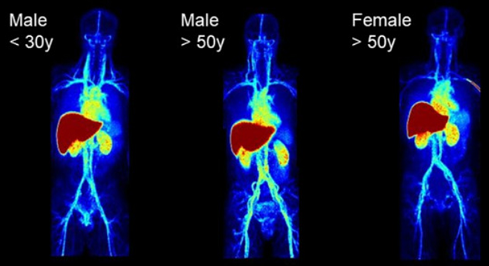OATPs AND DRUG KINETIC PERFORMANCE
OATP transporters constitute a family of membrane proteins essential for the hepatic elimination of certain drugs and other xenobiotics. Their activity therefore determines drug pharmacokinetics, which is usually assessed in human blood. However, due to a lack of tools, the correlation between OATP activity and blood drug elimination has never been established. Moreover, it remains unclear whether OATP activity contributes to pharmacokinetic variability linked to age or sex. Researchers from SHFJ, in collaboration with clinicians from Kremlin-Bicêtre Hospital (AP-HP), demonstrated that hepatic OATP function can be studied non-invasively and quantitatively using 11C-glyburide, a metabolically stable OATP tracer recently developed for positron emission tomography (PET). 11C-glyburide is mainly transported by the OATP1B1 isoform, which mediates its clearance from blood to liver.
11C-GLYBURIDE PET IMAGING FOR MONITORING PHARMACOKINETIC VARIABILITY
To explore sex- and age-related differences in OATP function, the researchers used 11C-glyburide in dynamic whole-body PET/MRI pharmacokinetic (WBPK) experiments and compared WBPK data between healthy men and women over 50 years of age. Data previously obtained in older men (>50 years) were compared with those from younger men (<30 years) using the same methodology. The blood-to-liver transfer rate constant (kuptake) was estimated to describe in vivo hepatic OATP function. Imaging data showed that hepatic exposure to the radiolabeled drug was 42.6 ± 18.4% higher (P < 0.05) in women over 50 compared with men of the same age, with higher kuptake values but no difference in blood exposure. In men, neither hepatic nor blood exposure, nor uptake, was affected by aging. Therefore, OATP function may underlie significant sex-related differences in hepatic exposure that are not detectable through conventional blood pharmacokinetics.

This study demonstrates that OATP transporters appear to play an important role in interindividual variability of hepatic drug exposure, potentially leading to greater susceptibility to drug-induced liver toxicity in women. Conversely, unlike renal filtration, which decreases with age, hepatic OATP activity does not appear to decline over time and therefore does not contribute to the reduced drug clearance commonly observed with aging.
Joliot contact: Nicolas Tournier (nicolas.tournier1@universite-paris-saclay.fr)